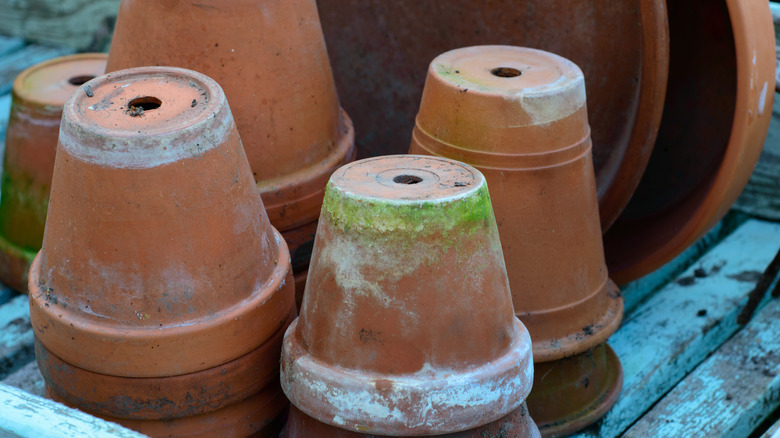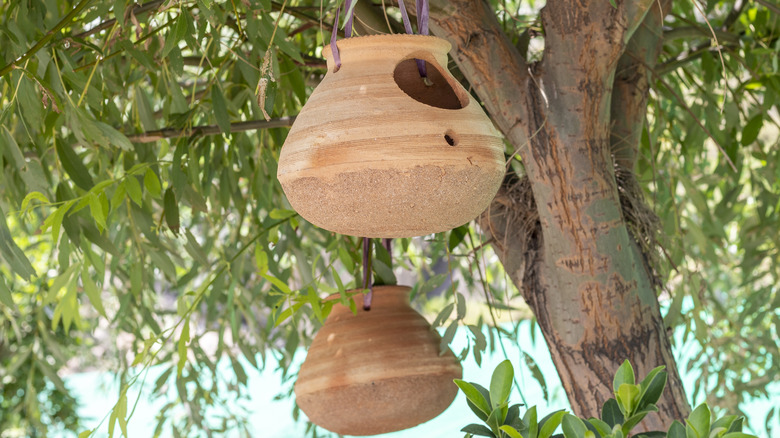Repurpose An Old Terra-Cotta Pot Into A Simple DIY Birdhouse For Your Backyard
PVC pipe, metal, acrylic, treated wood — using these materials when building a birdhouse is a big mistake. They don't provide enough ventilation, insulation, or grip for birdy claws. Worse, they may contain chemicals harmful to our feathered friends. But what about terra-cotta? Unglazed clay is naturally insulating, has a rough, grippy texture, and will hold its shape if it gets wet in the rain. To make one for yourself, all you need is an unglazed ceramic planter in a size preferred by the species of bird you wish to provide a nesting site for (more on this later), a round of wood, and some simple carpentry tools.
Are ceramic birdhouses safe for birds? Expert opinions appear mixed, though it seems a terra-cotta pot birdhouse would still work so long as you add ventilation and hang it in the right spot. Naysayers argue that nest boxes are prone to overheating or getting too cold. They're much heavier than timber birdhouses, making it easier for them to break or fall. What's more, the bird itself may not realize the downsides of their new home until the worst has happened to their eggs or growing chicks. (You might, for example, be dealing with a decidedly un-fussy avian visitor like the Carolina wren — a bird well-known to nest in just about any cavity!) Conversely, terra-cotta nest boxes have a long history of use in urban settings, and specific types of ceramic birdhouses are sometimes a preferred material in avian wildlife conservation.
Terra-cotta birdhouses have a long history of use
Terra-cotta and clay brick were the nest box materials favored by bird-loving residents of Turkish cities between the 15th and 19th centuries. Many such birdhouses can still be seen on buildings there. Fast forward to today, and not only have birds been known to nest between the gaps in ceramic roof tiles on suburban homes in the United States, but researchers are turning to ceramics to house baby birds in nature preserves. Ceramic nest chambers keep the chicks of the seabird Cassin's auklet over 1 degree Celsius cooler than their wooden counterparts on San Francisco's Southeast Farallon Island. In South Africa, endemic penguins tend to their young in waterproof shelters made from reconstituted ceramic powder.
Make sure any terra-cotta birdhouse you use has ventilation holes, ideally at the top of the box or cone, drainage holes, and easy access for cleaning and checking on the inhabitants if needed. After all, hot air rises. Avoid glazed ceramic pots, which may contain toxins like lead — a potential problem in glazed vintage ceramics made before 2011 and traditional pottery — and deprive landing parent birds or new-to-flying chicks of much-needed grip. Well-designed pottery birdhouses are considered really durable — unless, of course, you drop them! The best place to put your birdhouse, especially one made of terra-cotta or another type of ceramic, to keep the newly hatched bird babies at the correct temperature is somewhere shaded from the harsh midday and afternoon sun through the summer months.
Craft your terra-cotta pot birdhouse using simple tools and materials
A terra-cotta planter 4 to 6 inches in diameter and 6 to 12 inches tall will house most backyard bird species. To make an entrance hole, you could enlarge the existing drainage hole using a rat-tail file. Alternatively, drill a hole in the side of your pot or the wooden or ceramic base of your birdhouse with a diamond core drill bit. How big the hole needs to be depends on the bird species. For example, nuthatches prefer a 1-inch diameter hole, whereas woodpeckers need a 4-inch hole.
The Natural History Museum says to attach a square wooden base to an upturned planter by hammering four nails into the wood and using them to wind the wire up the planter. You could also fit a round wooden base snugly into the mouth of your pot and seal it in place with construction adhesive. Alternatively, apply the aforementioned glue to the top of your planter and upturn it onto a ceramic water saucer. Hang your new terra-cotta birdhouse from the drainage hole or use said hole to attach the planter to a wall or tree.
While it may be tempting, don't paint over-the-top colors on your birdhouse — only muted or specific colors are best to attract flying friends. Bright colors are more likely to attract predators. The earthy tone of the unfinished terra-cotta blends in with its surroundings better. Don't add a perch for the same reason.

